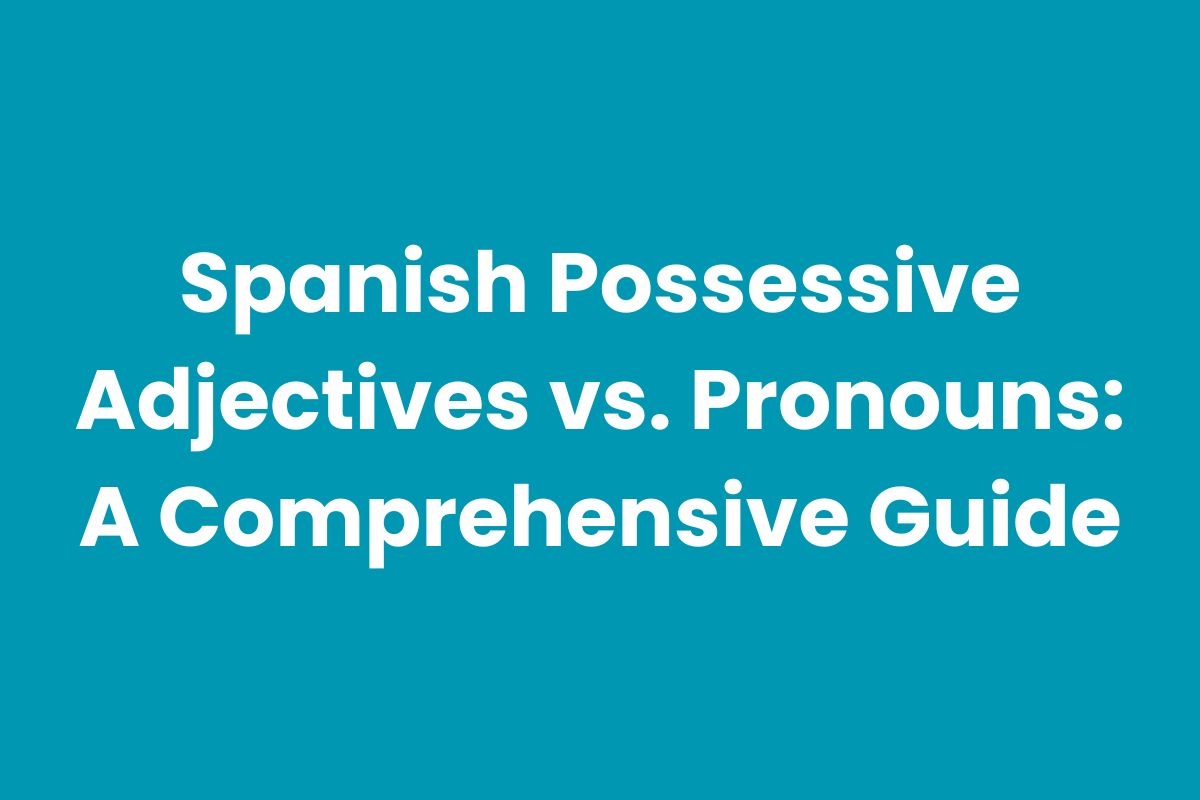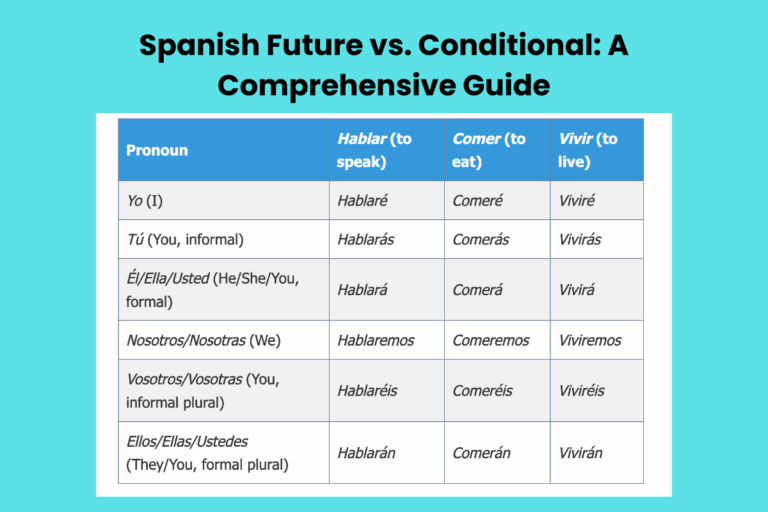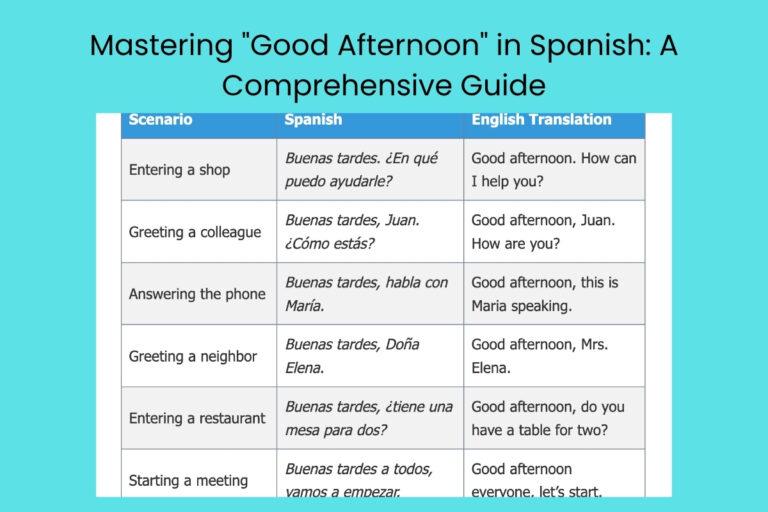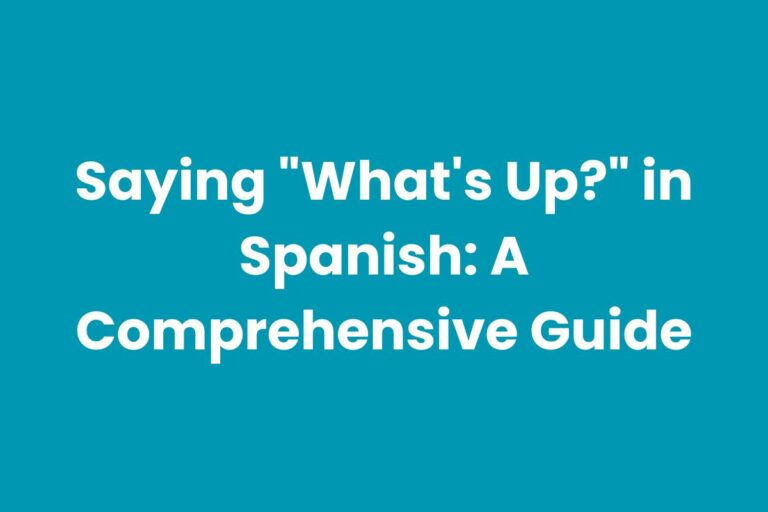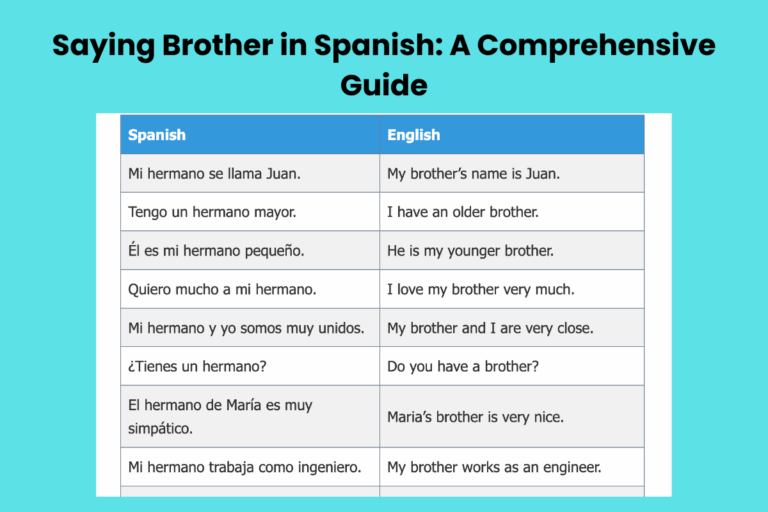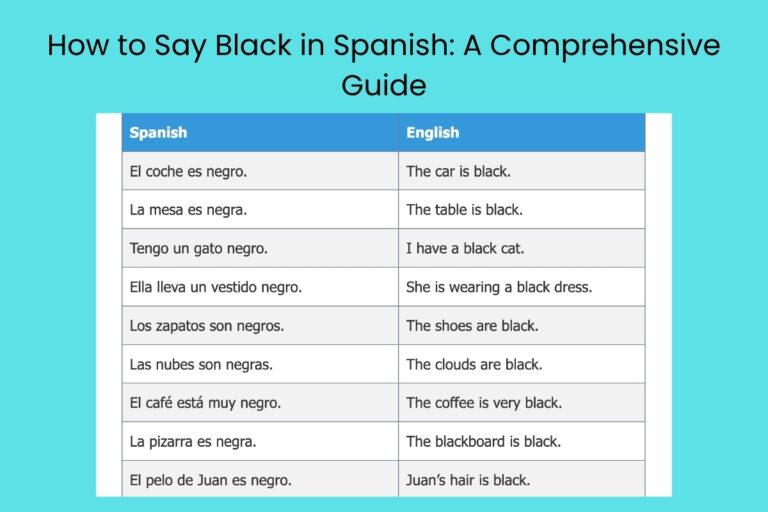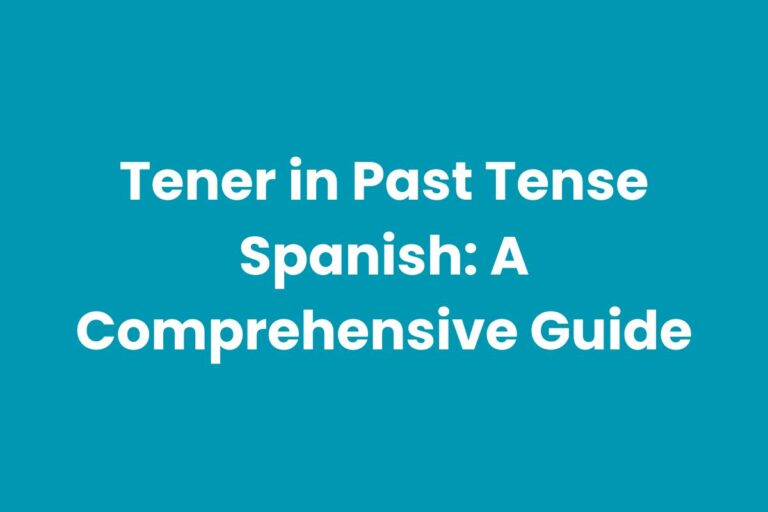Spanish Possessive Adjectives vs. Pronouns: A Comprehensive Guide
Mastering possessive adjectives and pronouns in Spanish is crucial for expressing ownership and relationships accurately. These grammatical elements allow you to indicate who or what something belongs to, adding depth and clarity to your communication.
This guide will navigate you through the intricacies of Spanish possessives, distinguishing between adjectives and pronouns, their forms, usage rules, and common pitfalls. Whether you’re a beginner or an advanced learner, understanding these concepts will significantly enhance your fluency and comprehension of the Spanish language.
This article will benefit students at all levels, from those just starting their Spanish journey to advanced learners looking to refine their grammar skills. Native English speakers will find this guide particularly helpful as it highlights the differences between English and Spanish possessive structures, aiding in accurate translation and expression.
By the end of this article, you will be equipped with the knowledge and practice needed to confidently use Spanish possessive adjectives and pronouns in various contexts.
Table of Contents
- Definition: Possessive Adjectives and Pronouns in Spanish
- Structural Breakdown
- Types and Categories
- Examples
- Usage Rules
- Common Mistakes
- Practice Exercises
- Advanced Topics
- FAQ
- Conclusion
Definition: Possessive Adjectives and Pronouns in Spanish
Possessive adjectives and pronouns in Spanish are grammatical tools used to indicate ownership or a relationship between a person (or thing) and something else. They specify to whom or to what something belongs.
Understanding the distinction between these two forms is crucial for accurate and natural Spanish communication.
Possessive adjectives modify nouns, directly preceding them to indicate possession. They agree in gender and number with the noun they modify, not with the possessor. For instance, in the phrase “mi casa” (my house), “mi” is the possessive adjective modifying the noun “casa” (house). The form of “mi” doesn’t change based on whether the speaker is male or female; it only changes if the noun is plural (“mis casas” – my houses).
Possessive pronouns, on the other hand, replace the noun phrase, standing in for both the possessor and the possessed item. They also agree in gender and number with the noun they replace. An example would be: “Este libro es mío” (This book is mine). Here, “mío” replaces “mi libro” (my book). The gender and number of “mío” match the implied noun “libro” (masculine, singular).
The function of possessive adjectives is to describe or specify which noun is being referred to. Their context is always adjectival, meaning they modify a noun. Possessive pronouns function as nouns themselves, often following the verb “ser” (to be) or standing alone in a sentence to avoid repetition. The context dictates whether an adjective or a pronoun is needed, based on whether the noun is explicitly stated or implied.
Structural Breakdown
The structure of Spanish possessive adjectives and pronouns involves several key elements that determine their correct usage. These elements include the possessor (the person or thing that owns something), the possessed (the item being owned), and the agreement in gender and number between the possessive form and the possessed item.
Possessive Adjectives: These always precede the noun they modify. The forms vary depending on the possessor. For the first-person singular (I), the forms are “mi” (singular) and “mis” (plural). For the second-person singular informal (you), the forms are “tu” (singular) and “tus” (plural). For the third-person singular (he, she, it), second-person formal (you), and third-person plural (they), the forms are “su” (singular) and “sus” (plural). It’s vital to remember that “su” and “sus” can be ambiguous, as they cover multiple possessors. To avoid ambiguity, Spanish often uses the construction “de + pronoun” (e.g., “el libro de él” – his book).
Possessive Pronouns: These replace the noun and require an article (el, la, los, las) before them. The forms are more varied than the adjectives and must agree in gender and number with the noun they replace. For example, “el mío” (masculine singular, meaning “mine”), “la mía” (feminine singular, meaning “mine”), “los míos” (masculine plural, meaning “mines”), and “las mías” (feminine plural, meaning “mines”). The article is crucial for identifying these forms as pronouns rather than adjectives.
The agreement rule is paramount: the possessive adjective *always* agrees with the noun it modifies, never with the possessor. The possessive pronoun agrees with the noun it replaces.
Understanding this distinction is fundamental to using possessives correctly in Spanish.
Types and Categories
Possessive Adjectives
Possessive adjectives in Spanish are used to indicate ownership or a relationship between a person or thing and another noun. They precede the noun and must agree in number with the noun they modify.
The forms are generally straightforward, but it’s crucial to understand how they change based on the possessor.
The short forms of possessive adjectives (mi, tu, su, nuestro/a, vuestro/a, su) are used before nouns. The forms “nuestro/a” and “vuestro/a” also agree in gender (masculine/feminine) with the noun. For example, “nuestro libro” (our book – masculine) and “nuestra casa” (our house – feminine).
Here’s a table summarizing the possessive adjectives:
| Possessor | Singular Noun | Plural Noun |
|---|---|---|
| Yo (I) | mi | mis |
| Tú (You, informal) | tu | tus |
| Él/Ella/Usted (He/She/You, formal) | su | sus |
| Nosotros/Nosotras (We) | nuestro/nuestra | nuestros/nuestras |
| Vosotros/Vosotras (You, informal plural – Spain) | vuestro/vuestra | vuestros/vuestras |
| Ellos/Ellas/Ustedes (They/You, formal plural) | su | sus |
Possessive Pronouns
Possessive pronouns replace the noun phrase and must agree in both gender and number with the noun they replace. They are typically preceded by a definite article (el, la, los, las).
Unlike possessive adjectives, possessive pronouns have distinct forms for masculine and feminine, as well as singular and plural. For example, to say “mine,” you would use “el mío” (masculine singular), “la mía” (feminine singular), “los míos” (masculine plural), or “las mías” (feminine plural), depending on the noun being replaced.
Here’s a table summarizing the possessive pronouns:
| Possessor | Masculine Singular | Feminine Singular | Masculine Plural | Feminine Plural |
|---|---|---|---|---|
| Yo (I) | el mío | la mía | los míos | las mías |
| Tú (You, informal) | el tuyo | la tuya | los tuyos | las tuyas |
| Él/Ella/Usted (He/She/You, formal) | el suyo | la suya | los suyos | las suyas |
| Nosotros/Nosotras (We) | el nuestro | la nuestra | los nuestros | las nuestras |
| Vosotros/Vosotras (You, informal plural – Spain) | el vuestro | la vuestra | los vuestros | las vuestras |
| Ellos/Ellas/Ustedes (They/You, formal plural) | el suyo | la suya | los suyos | las suyas |
Examples
This section provides extensive examples of both possessive adjectives and pronouns, illustrating their usage in various contexts. These examples are categorized to help you understand the nuances of each form.
Possessive Adjective Examples
The following table provides examples of possessive adjectives in sentences. Notice how the adjective always precedes the noun and agrees in number with it. The gender of the possessor does *not* affect the form of the adjective (except for nuestro/a and vuestro/a, which agree in gender with the possessed noun).
| Sentence | Translation |
|---|---|
| Mi libro es interesante. | My book is interesting. |
| Tus ideas son geniales. | Your ideas are great. |
| Su coche es rojo. | His/Her/Your (formal) car is red. |
| Nuestro perro es pequeño. | Our dog is small. |
| Nuestra casa es grande. | Our house is big. |
| Vuestros padres son amables. | Your (plural, informal – Spain) parents are kind. |
| Vuestra bicicleta es nueva. | Your (plural, informal – Spain) bicycle is new. |
| Sus amigos son divertidos. | Their/Your (formal plural) friends are fun. |
| Mi hermana es doctora. | My sister is a doctor. |
| Tus zapatos son caros. | Your shoes are expensive. |
| Su trabajo es importante. | His/Her/Your (formal) job is important. |
| Nuestro problema es complicado. | Our problem is complicated. |
| Nuestra solución es simple. | Our solution is simple. |
| Vuestros esfuerzos son apreciados. | Your (plural, informal – Spain) efforts are appreciated. |
| Vuestra dedicación es admirable. | Your (plural, informal – Spain) dedication is admirable. |
| Sus planes son ambiciosos. | Their/Your (formal plural) plans are ambitious. |
| Mi familia es importante para mí. | My family is important to me. |
| Tus consejos son muy útiles. | Your advice is very useful. |
| Su opinión es respetada. | His/Her/Your (formal) opinion is respected. |
| Nuestro equipo es el mejor. | Our team is the best. |
| Nuestra ciudad es hermosa. | Our city is beautiful. |
| Vuestros logros son impresionantes. | Your (plural, informal – Spain) achievements are impressive. |
| Vuestra pasión es contagiosa. | Your (plural, informal – Spain) passion is contagious. |
| Sus resultados son excelentes. | Their/Your (formal plural) results are excellent. |
| Mi país es bonito. | My country is beautiful. |
| Tus ideas son interesantes. | Your ideas are interesting. |
Possessive Pronoun Examples
The following table provides examples of possessive pronouns in sentences. Notice how the pronoun replaces the noun phrase and agrees in *both* gender and number with the noun it replaces.
The definite article (el, la, los, las) precedes the possessive pronoun.
| Sentence | Translation |
|---|---|
| Este libro es mío. | This book is mine. |
| La casa roja es la tuya. | The red house is yours. |
| El coche es suyo. | The car is his/hers/yours (formal). |
| El perro pequeño es el nuestro. | The small dog is ours. |
| La casa grande es la nuestra. | The big house is ours. |
| Los padres amables son los vuestros. | The kind parents are yours (plural, informal – Spain). |
| La bicicleta nueva es la vuestra. | The new bicycle is yours (plural, informal – Spain). |
| Los amigos divertidos son los suyos. | The fun friends are theirs/yours (formal plural). |
| Esta pluma es la mía. | This pen is mine. |
| Esos zapatos son los tuyos. | Those shoes are yours. |
| El trabajo importante es el suyo. | The important job is his/hers/yours (formal). |
| El problema complicado es el nuestro. | The complicated problem is ours. |
| La solución simple es la nuestra. | The simple solution is ours. |
| Esos esfuerzos son los vuestros. | Those efforts are yours (plural, informal – Spain). |
| Esa dedicación es la vuestra. | That dedication is yours (plural, informal – Spain). |
| Los planes ambiciosos son los suyos. | The ambitious plans are theirs/yours (formal plural). |
| La decisión final es la mía. | The final decision is mine. |
| Estos bolígrafos son los tuyos. | These pens are yours. |
| El premio es el suyo. | The price is his/hers/yours (formal). |
| El jardín grande es el nuestro. | The big garden is ours. |
| La idea original es la nuestra. | The original idea is ours. |
| Los trofeos brillantes son los vuestros. | The shiny trophies are yours (plural, informal – Spain). |
| La medalla de oro es la vuestra. | The golden medal is yours (plural, informal – Spain). |
| Los errores comunes son los suyos. | The common mistakes are theirs/yours (formal plural). |
| El coche nuevo es el mío. | The new car is mine. |
| La casa antigua es la tuya. | The old house is yours. |
Usage Rules
Several rules govern the correct usage of possessive adjectives and pronouns in Spanish. Adhering to these rules is essential for clear and accurate communication.
- Agreement: Possessive adjectives agree in number with the noun they modify. Possessive pronouns agree in gender and number with the noun they replace.
- Placement: Possessive adjectives precede the noun. Possessive pronouns replace the noun phrase and are usually preceded by a definite article.
- Ambiguity of “su/sus”: Since “su” and “sus” can refer to él, ella, usted, ellos, ellas, and ustedes, ambiguity can arise. To avoid this, use the construction “de + pronoun”. For example, instead of “su libro” (his/her/your/their book), you can say “el libro de él” (his book), “el libro de ella” (her book), “el libro de usted” (your book), “el libro de ellos” (their book), etc.
- Use of Articles with Pronouns: Always use a definite article (el, la, los, las) before a possessive pronoun. This distinguishes it from a possessive adjective and indicates that it’s replacing a noun.
- Omission of Noun: The noun that the possessive pronoun replaces must be clear from the context. Otherwise, the sentence will be confusing.
Exceptions to these rules are rare, but it’s important to be aware of regional variations. In some Latin American countries, the use of “vuestro/a” and “vosotros/as” is less common, and “ustedes” is used instead, making “su/sus” even more prevalent. Context and clear communication are key in these situations.
Common Mistakes
Learners often make mistakes with possessive adjectives and pronouns in Spanish. Understanding these common errors can help you avoid them.
| Incorrect | Correct | Explanation |
|---|---|---|
| Mi casa es grande y tu también. | Mi casa es grande y la tuya también. | The possessive pronoun “la tuya” is needed to replace “tu casa”. |
| Este es mi libro y ese es su. | Este es mi libro y ese es el suyo. | The possessive pronoun “el suyo” is needed to replace “su libro”, and it requires the article “el”. |
| Su libro es interesante, pero su no. | Su libro es interesante, pero el de él no. | To avoid ambiguity, “el de él” clarifies that you are referring to *his* book, not someone else’s. |
| Nuestros coche es rojo. | Nuestro coche es rojo. | “Coche” is masculine, so “nuestro” is correct. The common mistake is to confuse gender. |
| El problema es mío, no tu. | El problema es mío, no tuyo. | The possessive pronoun “tuyo” is required to replace “el tuyo”. |
| Mis hermano es alto. | Mi hermano es alto. | “Hermano” is singular, so “mi” is correct. The common mistake is to confuse singular/plural. |
| La decisión es suyo. | La decisión es suya. | “Decisión” is feminine, so “suya” is required. |
| Este es mi perro, donde está tu? | Este es mi perro, ¿dónde está el tuyo? | The article “el” is needed before “tuyo.” |
| Sus casa es grande. | Su casa es grande. | “Casa” is singular, so “su” is correct. The common mistake is to confuse singular/plural. |
| Nuestra libros son interesantes. | Nuestros libros son interesantes. | “Libros” is plural, so “nuestros” is required. |
Another common mistake is using the English possessive apostrophe (e.g., “John’s book”). Spanish does not use this construction; instead, it uses “de + noun/pronoun” (e.g., “el libro de Juan”).
Practice Exercises
These exercises will help you practice using possessive adjectives and pronouns correctly. Each exercise focuses on a different aspect of possessive usage.
Exercise 1: Choose the Correct Possessive Adjective
Choose the correct possessive adjective to complete each sentence.
| Question | Options | Answer |
|---|---|---|
| ¿Dónde está _________ (my) coche? | a) mi b) mis c) mío | a) mi |
| _________ (Your, informal) amigos son muy simpáticos. | a) tu b) tus c) tuyos | b) tus |
| _________ (His/Her/Your, formal) casa es muy grande. | a) su b) sus c) suyo | a) su |
| _________ (Our) perro es muy juguetón. | a) nuestro b) nuestra c) nuestros | a) nuestro |
| _________ (Your, plural informal – Spain) ideas son muy creativas. | a) vuestro b) vuestros c) vuestras | c) vuestras |
| _________ (Their/Your, formal plural) padres son muy amables. | a) su b) sus c) suyos | b) sus |
| ¿Tienes _________ (my) número de teléfono? | a) mi b) mis c) mío | a) mi |
| _________ (Your, informal) familia es muy unida. | a) tu b) tus c) tuyo | a) tu |
| _________ (His/Her/Your, formal) nombre es muy común. | a) su b) sus c) suyo | a) su |
| _________ (Our) proyecto es muy importante. | a) nuestro b) nuestra c) nuestros | a) nuestro |
Exercise 2: Choose the Correct Possessive Pronoun
Choose the correct possessive pronoun to complete each sentence.
| Question | Options | Answer |
|---|---|---|
| Este libro es _________ (mine). | a) mi b) mío c) el mío | c) el mío |
| La casa roja es _________ (yours, informal). | a) tuya b) la tuya c) tus | b) la tuya |
| El coche es _________ (his/hers/yours, formal). | a) suyo b) el suyo c) sus | b) el suyo |
| El perro pequeño es _________ (ours). | a) nuestro b) el nuestro c) nuestros | b) el nuestro |
| La casa grande es _________ (ours). | a) nuestra b) la nuestra c) nuestros | b) la nuestra |
| Los padres amables son _________ (yours, plural informal – Spain). | a) vuestros b) los vuestros c) vuestras | b) los vuestros |
| La bicicleta nueva es _________ (yours, plural informal – Spain). | a) vuestra b) la vuestra c) vuestros | b) la vuestra |
| Los amigos divertidos son _________ (theirs/yours, formal plural). | a) suyos b) los suyos c) su | b) los suyos |
| Esta pluma es _________ (mine). | a) mía b) la mía c) mis | b) la mía |
| Esos zapatos son _________ (yours). | a) tuyos b) los tuyos c) tu | b) los tuyos |
Exercise 3: Translate the Sentences
Translate the following sentences into Spanish, using possessive adjectives or pronouns as appropriate.
| English Sentence | Spanish Translation |
|---|---|
| My car is blue. | Mi coche es azul. |
| Your (informal) books are interesting. | Tus libros son interesantes. |
| This house is mine. | Esta casa es la mía. |
| Their (masculine) problems are difficult. | Sus problemas son difíciles / Los problemas de ellos son difíciles. |
| Our school is big. | Nuestra escuela es grande. |
| The decision is yours (formal). | La decisión es suya. |
| Your (plural, informal – Spain) efforts are appreciated. | Vuestros esfuerzos son apreciados. |
| This pen is hers. | Esta pluma es la suya / Esta pluma es de ella. |
| My family is important to me. | Mi familia es importante para mí. |
| Where is your (informal) passport? | ¿Dónde está tu pasaporte? |
Advanced Topics
For advanced learners, there are nuances and complexities in the use of Spanish possessives that go beyond the basic rules. These include:
- Emphasis: To emphasize possession, Spanish speakers might use constructions like “Es *mi propia* casa” (It’s *my own* house) or “Es *su mismo* coche” (It’s *his very own* car).
- Figurative Language: Possessives can be used figuratively to express relationships beyond ownership. For example, “Es mi amigo” (He’s my friend) doesn’t imply ownership but a close relationship.
- Regional Variations: As mentioned before, the use of “vuestro/a” is less common in Latin America. Additionally, some regions might have slight variations in pronoun usage or preferred constructions.
- Possessive Datives: Spanish sometimes uses a dative pronoun to indicate possession, particularly with body parts or clothing. For example, “Se lavó las manos” (He washed his hands) literally translates to “He washed the hands *to himself*.”
Mastering these advanced topics requires extensive exposure to the language and a keen ear for subtle differences in usage.
FAQ
- What is the difference between “su” and “sus”?
“Su” is used with singular nouns, while “sus” is used with plural nouns. Both can refer to él, ella, usted, ellos, ellas, or ustedes. The form depends on the number of the noun being possessed, not the number of possessors.
- How can I avoid ambiguity when using “su” and “sus”?
To avoid ambiguity, use the construction “de + pronoun”. For example, instead of “su libro”, say “el libro de él” (his book), “el libro de ella” (her book), etc.
- Do possessive adjectives agree in gender with the possessor?
No, possessive adjectives generally agree in gender with the noun they modify, not with the possessor. The exceptions are “nuestro/a” and “vuestro/a”, which agree in gender and number with the noun.
- When do I use a possessive adjective versus a possessive pronoun?
Use a possessive adjective when you want to modify a noun directly to indicate possession. Use a possessive pronoun when you want to replace the noun phrase altogether, avoiding repetition.
- Why do possessive pronouns need an article before them?
The definite article (el, la, los, las) is necessary to identify the word as a possessive pronoun rather than an adjective. It signals that the word is replacing a noun phrase.
- Are there any regional differences in the use of possessive adjectives and pronouns?
Yes, in many Latin American countries, the forms “vuestro/a” and “vosotros/as” are not commonly used. Instead, “ustedes” is used, so “su/sus” covers both the formal and informal plural “you.”
- How do I translate “John’s car” into Spanish?
Spanish does not use the possessive apostrophe like English. Instead, use the construction “el coche de Juan” (the car of John).
- Can I use possessive adjectives with body parts in Spanish?
While you *can*, it’s more common to use a reflexive verb and a definite article. For example, instead of “Lavé mi cara” (I washed my face), it’s more natural to say “Me lavé la cara” (I washed the face to myself).
- What is a possessive dative?
A possessive dative is the use of a dative pronoun (me, te, le, nos, os, les) to indicate possession, especially with body parts or clothing. For instance, “Se rompió la pierna” (He broke his leg) literally means “He broke the leg to himself.”
- Is it always necessary to use “de + pronoun” to clarify “su/sus”?
While it’s highly recommended to avoid ambiguity, context can sometimes make the meaning clear. However, when there’s any possibility of confusion, using “de + pronoun” is the best practice.
Conclusion
Understanding the difference between Spanish possessive adjectives and pronouns is essential for expressing ownership and relationships accurately. Possessive adjectives modify nouns, while possessive pronouns replace entire noun phrases.
Mastering their forms and usage rules will significantly enhance your ability to communicate effectively in Spanish.
Remember to pay close attention to agreement in gender and number, avoid the ambiguity of “su/sus” by using “de + pronoun” when necessary, and practice regularly to solidify your understanding. By incorporating these concepts into your Spanish studies, you’ll achieve a higher level of fluency and confidence in your language skills. Keep practicing with real-life examples and don’t be afraid to ask for feedback. ¡Buena suerte!

